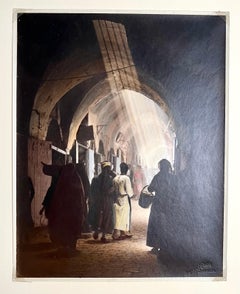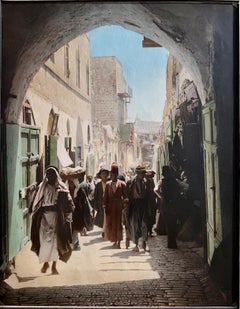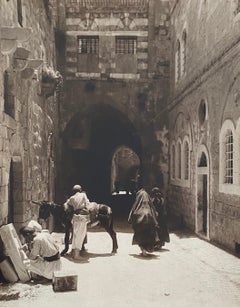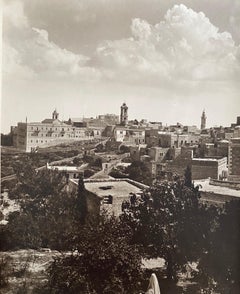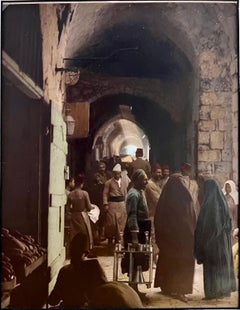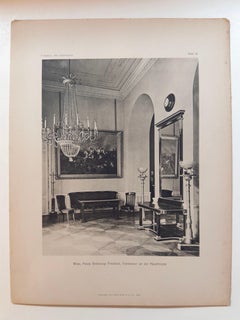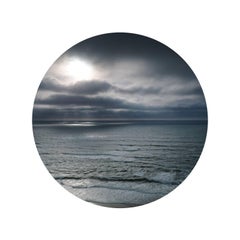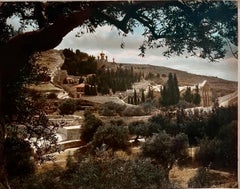American Colony Jerusalem Art
to
7
4
4
3
3
Vintage Large Albumen Photo Jerusalem Photograph American Colony Old City Market
By American Colony Jerusalem
Located in Surfside, FL
The mat measures 21 X 16 the images are around 12 X 9 inches. They bear the blindstamp of the American Colony Jerusalem.
I am not sure if these are hand colored but they are from th...
Category
Early 20th Century Academic American Colony Jerusalem Art
Materials
Photographic Paper
Vintage Large Albumen Photo Jerusalem Photograph American Colony Old City Market
By American Colony Jerusalem
Located in Surfside, FL
The mat measures 21 X 16 the images are around 12 X 9 inches. They bear the blindstamp of the American Colony Jerusalem.
I am not sure if these are hand colored but they are from th...
Category
Early 20th Century Academic American Colony Jerusalem Art
Materials
Photographic Paper
Vintage Large Albumen Photo Jerusalem Photograph American Colony Mt Zion Trees
By American Colony Jerusalem
Located in Surfside, FL
The mat measures 21 X 16 the images are around 12 X 9 inches. They bear the blindstamp of the American Colony Jerusalem.
I am not sure if these are hand colored but they are from th...
Category
Early 20th Century Academic American Colony Jerusalem Art
Materials
Photographic Paper
Vintage Large Albumen Photo Jerusalem - House Of The "Rich Man"
By American Colony Jerusalem
Located in Surfside, FL
The Original American Colony was a colony established in Jerusalem in 1881 by members of a utopian society led by Anna and Horatio Spafford. Now a hotel in East Jerusalem, it is still known by that name today.
After suffering a series tragic losses following the Great Chicago Fire of 1871 (see hymn "It is Well with My Soul"), Chicago residents Anna and Horatio Spafford led a small American contingent in 1881 to Jerusalem to form a utopian society. The "American Colony," as it became known, was later joined by Swedish Christians. The society engaged in philanthropic work amongst the people of Jerusalem regardless of religious affiliation, gaining the trust of the local Muslim, Jewish, and Christian communities.During and immediately after World War I, the American Colony carried out philanthropic work to alleviate the suffering of the local inhabitants, opening soup kitchens, hospitals, orphanages and other charitable ventures.
Towards the end of the 1950s, the society's communal residence was converted into the American Colony Hotel. The hotel is an integral part of the Jerusalem landscape where members of all communities in Jerusalem still meet. In 1992 representatives from the Palestine Liberation Organization and Israel met in the hotel where they began talks that led to the historic 1993 Oslo Peace Accord.
Panorama of Jerusalem, c. 1890-1920
The Colony moved to the large house of a wealthy Arab landowner, Rabbah Husseini, outside the city walls in Sheikh Jarrah on the road to Nablus. Part of the building was used as a hostel for visitors from Europe and America. A small farm developed with animals, a butchery, a dairy, a bakery, a carpenter's shop, and a smithy. The economy was supplemented by a shop selling photographs, craft items and archaeological artifacts. The American Colonists were embraced by the Jewish and Palestinian communities for their good works, among them, teaching in both Muslim and Jewish schools.
Photography
Around 1900, Elijah Meyers, a member of the American Colony, began taking photographs of places and events in and around the city of Jerusalem. Meyers's work eventually expanded into a full-fledged photographic division within the Colony, including Hol Lars (Lewis) Larsson and G. Eric Matson, who later renamed the effort as the Matson Photographic Service. Their interest in archeological artifacts (such as the Lion Tower in Tripoli pictured here), and the detail of their photographs, led to widespread interest in their work by archeologists. The collection was later donated to the Library of Congress.
World War I
When the Ottoman Empire entered World War I as an ally of Germany in November 1914, Jerusalem and Palestine became a battleground between the Allied and the Central powers...
Category
Late 19th Century Academic American Colony Jerusalem Art
Materials
Photographic Paper
Vintage Large Albumen Photo Jerusalem Landscape
By American Colony Jerusalem
Located in Surfside, FL
The Original American Colony was a colony established in Jerusalem in 1881 by members of a utopian society led by Anna and Horatio Spafford. Now a hotel in East Jerusalem, it is still known by that name today.
After suffering a series tragic losses following the Great Chicago Fire of 1871 (see hymn "It is Well with My Soul"), Chicago residents Anna and Horatio Spafford led a small American contingent in 1881 to Jerusalem to form a utopian society. The "American Colony," as it became known, was later joined by Swedish Christians. The society engaged in philanthropic work amongst the people of Jerusalem regardless of religious affiliation, gaining the trust of the local Muslim, Jewish, and Christian communities.During and immediately after World War I, the American Colony carried out philanthropic work to alleviate the suffering of the local inhabitants, opening soup kitchens, hospitals, orphanages and other charitable ventures.
Towards the end of the 1950s, the society's communal residence was converted into the American Colony Hotel. The hotel is an integral part of the Jerusalem landscape where members of all communities in Jerusalem still meet. In 1992 representatives from the Palestine Liberation Organization and Israel met in the hotel where they began talks that led to the historic 1993 Oslo Peace Accord.
Panorama of Jerusalem, c. 1890-1920
The Colony moved to the large house of a wealthy Arab landowner, Rabbah Husseini, outside the city walls in Sheikh Jarrah on the road to Nablus. Part of the building was used as a hostel for visitors from Europe and America. A small farm developed with animals, a butchery, a dairy, a bakery, a carpenter's shop, and a smithy. The economy was supplemented by a shop selling photographs, craft items and archaeological artifacts. The American Colonists were embraced by the Jewish and Palestinian communities for their good works, among them, teaching in both Muslim and Jewish schools.
Photography
Around 1900, Elijah Meyers, a member of the American Colony, began taking photographs of places and events in and around the city of Jerusalem. Meyers's work eventually expanded into a full-fledged photographic division within the Colony, including Hol Lars (Lewis) Larsson and G. Eric Matson, who later renamed the effort as the Matson Photographic Service. Their interest in archeological artifacts (such as the Lion Tower in Tripoli pictured here), and the detail of their photographs, led to widespread interest in their work by archeologists. The collection was later donated to the Library of Congress.
World War I
When the Ottoman Empire entered World War I as an ally of Germany in November 1914, Jerusalem and Palestine became a battleground between the Allied and the Central powers...
Category
Late 19th Century Academic American Colony Jerusalem Art
Materials
Photographic Paper
Vintage Large Albumen Photo Jerusalem Photograph American Colony Old City Market
By American Colony Jerusalem
Located in Surfside, FL
The mat measures 21 X 16 the images are around 12 X 9 inches. They bear the blindstamp of the American Colony Jerusalem.
I am not sure if these are hand colored but they are from th...
Category
Early 20th Century Academic American Colony Jerusalem Art
Materials
Photographic Paper
Vintage Large Albumen Photo - Via Dolorosa In Station Of The Bross. Jerusalem
By American Colony Jerusalem
Located in Surfside, FL
The Original American Colony was a colony established in Jerusalem in 1881 by members of a utopian society led by Anna and Horatio Spafford. Now a hotel in East Jerusalem, it is still known by that name today.
After suffering a series tragic losses following the Great Chicago Fire of 1871 (see hymn "It is Well with My Soul"), Chicago residents Anna and Horatio Spafford led a small American contingent in 1881 to Jerusalem to form a utopian society. The "American Colony," as it became known, was later joined by Swedish Christians. The society engaged in philanthropic work amongst the people of Jerusalem regardless of religious affiliation, gaining the trust of the local Muslim, Jewish, and Christian communities.During and immediately after World War I, the American Colony carried out philanthropic work to alleviate the suffering of the local inhabitants, opening soup kitchens, hospitals, orphanages and other charitable ventures.
Towards the end of the 1950s, the society's communal residence was converted into the American Colony Hotel. The hotel is an integral part of the Jerusalem landscape where members of all communities in Jerusalem still meet. In 1992 representatives from the Palestine Liberation Organization and Israel met in the hotel where they began talks that led to the historic 1993 Oslo Peace Accord.
Panorama of Jerusalem, c. 1890-1920
The Colony moved to the large house of a wealthy Arab landowner, Rabbah Husseini, outside the city walls in Sheikh Jarrah on the road to Nablus. Part of the building was used as a hostel for visitors from Europe and America. A small farm developed with animals, a butchery, a dairy, a bakery, a carpenter's shop, and a smithy. The economy was supplemented by a shop selling photographs, craft items and archaeological artifacts. The American Colonists were embraced by the Jewish and Palestinian communities for their good works, among them, teaching in both Muslim and Jewish schools.
Photography
Around 1900, Elijah Meyers, a member of the American Colony, began taking photographs of places and events in and around the city of Jerusalem. Meyers's work eventually expanded into a full-fledged photographic division within the Colony, including Hol Lars (Lewis) Larsson and G. Eric Matson, who later renamed the effort as the Matson Photographic Service. Their interest in archeological artifacts (such as the Lion Tower in Tripoli pictured here), and the detail of their photographs, led to widespread interest in their work by archeologists. The collection was later donated to the Library of Congress.
World War I
When the Ottoman Empire entered World War I as an ally of Germany in November 1914, Jerusalem and Palestine became a battleground between the Allied and the Central powers...
Category
Late 19th Century Academic American Colony Jerusalem Art
Materials
Photographic Paper
Related Items
Plate 25: "Vienna, Palais Erzherzog Friedrich, Anteroom at the main staircase"
Located in New York, NY
This photogravure is twenty fifth plate presented in Josef Folnesics publication "Alte Innenräume österreichischer Schlösser, Paläste und Wohnhäuser" (Old interiors of Austrian Castl...
Category
1920s Academic American Colony Jerusalem Art
Materials
Photogravure
Seascape II - abstract ocean cloudscape in circular viewpoint (22" diameter)
By Frank Schott
Located in San Francisco, CA
Seascape II by Frank Schott
22 x 22 inches / 56cm x 56cm
signed edition of 50
42 x 42 inches / 107cm x 107cm
signed edition of 25
archival quality fine art pigment print
limited a...
Category
21st Century and Contemporary Contemporary American Colony Jerusalem Art
Materials
Archival Pigment, Archival Paper, Giclée
$910 Sale Price
30% Off
H 22 in W 22 in
Pier on misty Lake Panorama - black and white long exposure photography
By Gerald Berghammer
Located in Vienna, Vienna
Black and white fine art long exposure waterscape - landscape photography. Archival pigment ink print as part of a limited edition of 7. All Gerald Berghammer prints are made to orde...
Category
2010s Contemporary American Colony Jerusalem Art
Materials
Digital Pigment
$2,602
H 23.63 in W 42.13 in
Oasis (Sidewinder) - 21st Century, Contemporary, Polaroid, Landscape
By Stefanie Schneider
Located in Morongo Valley, CA
Oasis (Sidewinder), 2005, Edition 3/5, 16 pieces each 48x47cm
analog C-Prints, hand-printed by the artist, printed on Fuji Crystal Archive Paper,
based on Polaroids mounted on Aluminum with matte UV-Protection, based on an expired Polaroids, Artist inventory Number 3001.03
Installation shot at 'Mulholland Distilling' in LA with Danny Fox...
Category
Early 2000s Contemporary American Colony Jerusalem Art
Materials
Archival Paper, Photographic Paper, C Print, Color, Polaroid
$33,128
H 82.68 in W 82.68 in D 0.12 in
Benoit Fils - Archival fine art print, Black white, Montreal, Clydesdale truck
Located in Sant Cugat del Vallès, Barcelona
An archival pigment print on Hahnemühle Photo Rag® Baryta 315 g/m² paper, a photography of a delivery of foodstuffs from a shop of seeds, flour and provisions in Montreal cerca 1920 ...
Category
1920s Academic American Colony Jerusalem Art
Materials
Black and White, Giclée, Pigment, Archival Pigment, Digital Pigment
$993 Sale Price
30% Off
H 12.6 in W 15.75 in D 0.01 in
Morning light in the Mountains, black and white photography, landscape, limited
By Gerald Berghammer
Located in Vienna, Vienna
Black and white fine art panorama landscape photography print. Madeira's mountain peaks in the wonderful light at sunrise, Portugal. Archival pigment ink print, edition of 5. Signed,...
Category
2010s Contemporary American Colony Jerusalem Art
Materials
Digital Pigment
Tree in Lavender Field Panorama, black and white photograph, limited edition
By Gerald Berghammer
Located in Vienna, Vienna
Black and white fine art panorama landscape photography. Single tree in stony lavender field in Provence, France. Archival pigment ink print, edition of 7. Signed, titled, dated and ...
Category
21st Century and Contemporary Contemporary American Colony Jerusalem Art
Materials
Digital Pigment
$3,194
H 23.63 in W 47.25 in
Plate 6: Vienna, Palais Erzherzog Friedrich, Second View
Located in New York, NY
This photogravure is the sixth plate presented in Josef Folnesics publication "Alte Innenräume österreichischer Schlösser, Paläste und Wohnhäuser" (Old interiors of Austrian Castles,...
Category
1920s Academic American Colony Jerusalem Art
Materials
Photogravure
Plate 15: Vienna, Palais Erzherzog Friedrich, Dinning Room
Located in New York, NY
This photogravure is the sixth plate presented in Josef Folnesics publication "Alte Innenräume österreichischer Schlösser, Paläste und Wohnhäuser" (Old interiors of Austrian Castles,...
Category
1920s Academic American Colony Jerusalem Art
Materials
Photogravure
$450
H 16.5 in W 11 in
Lavender Field Panorama, France, black and white fine art landscape photography
By Gerald Berghammer
Located in Vienna, Vienna
Gerald Berghammer - Black and white landscape photography. Lavender field with a dirt path to a small house and a tall tree, under a sky with moving clouds.
Archival pigment ink pri...
Category
2010s Contemporary American Colony Jerusalem Art
Materials
Archival Ink, Archival Paper, Digital Pigment
$2,839
H 19.69 in W 59.06 in
Plate 7: Vienna, Palais Erzherzog Friedrich, Anteroom of the Smoking Room
Located in New York, NY
This photogravure is the sixth plate presented in Josef Folnesics publication "Alte Innenräume österreichischer Schlösser, Paläste und Wohnhäuser" (Old interiors of Austrian Castles,...
Category
1920s Academic American Colony Jerusalem Art
Materials
Photogravure
Plate 1: Vienna, Palais Erzherzog Friedrich, Vestibule
Located in New York, NY
This photogravure is the first plate presented in Josef Folnesics publication "Alte Innenräume österreichischer Schlösser, Paläste und Wohnhäuser" (Old interiors of Austrian Castles,...
Category
1920s Academic American Colony Jerusalem Art
Materials
Photogravure
Previously Available Items
Vintage Large Albumen Photo Jerusalem Photograph American Colony Old City Market
By American Colony Jerusalem
Located in Surfside, FL
The mat measures 21 X 16 the images are around 12 X 9 inches. They bear the blindstamp of the American Colony Jerusalem.
I am not sure if these are hand colored but they are from the period. Old City Shuk or Souq.
The Original American Colony was a colony established in Jerusalem in 1881 by members of a utopian society led by Anna and Horatio Spafford. Now a hotel in East Jerusalem, it is still known by that name today.
After suffering a series tragic losses following the Great Chicago Fire of 1871 (see hymn "It is Well with My Soul"), Chicago residents Anna and Horatio Spafford led a small American contingent in 1881 to Jerusalem to form a utopian society. The "American Colony," as it became known, was later joined by Swedish Christians. The society engaged in philanthropic work amongst the people of Jerusalem regardless of religious affiliation, gaining the trust of the local Muslim, Jewish, and Christian communities.During and immediately after World War I, the American Colony carried out philanthropic work to alleviate the suffering of the local inhabitants, opening soup kitchens, hospitals, orphanages and other charitable ventures.
Towards the end of the 1950s, the society's communal residence was converted into the American Colony Hotel. The hotel is an integral part of the Jerusalem landscape where members of all communities in Jerusalem still meet. In 1992 representatives from the Palestine Liberation Organization and Israel met in the hotel where they began talks that led to the historic 1993 Oslo Peace Accord.
Panorama of Jerusalem, c. 1890-1920
The Colony moved to the large house of a wealthy Arab landowner, Rabbah Husseini, outside the city walls in Sheikh Jarrah on the road to Nablus. Part of the building was used as a hostel for visitors from Europe and America. A small farm developed with animals, a butchery, a dairy, a bakery, a carpenter's shop, and a smithy. The economy was supplemented by a shop selling photographs, craft items and archaeological artifacts. The American Colonists were embraced by the Jewish and Palestinian communities for their good works, among them, teaching in both Muslim and Jewish schools.
Photography
Around 1900, Elijah Meyers, a member of the American Colony, began taking photographs of places and events in and around the city of Jerusalem. Meyers's work eventually expanded into a full-fledged photographic division within the Colony, including Hol Lars (Lewis) Larsson and G. Eric Matson, who later renamed the effort as the Matson Photographic Service. Their interest in archeological artifacts (such as the Lion Tower in Tripoli pictured here), and the detail of their photographs, led to widespread interest in their work by archeologists. The collection was later donated to the Library of Congress.
World War I
When the Ottoman Empire entered World War I as an ally of Germany in November 1914, Jerusalem and Palestine became a battleground between the Allied and the Central powers. The Allied forces from Egypt, under the leadership of the British, engaged the German, Austrian and Turkish forces in fierce battles for control of Palestine. During this time the American Colony assumed a more crucial role in supporting the local populace through the deprivations and hardships of the war. Because the Turkish military...
Category
Early 20th Century Academic American Colony Jerusalem Art
Materials
Photographic Paper
Vintage Large Albumen Photo Jerusalem Photograph American Colony Mt Zion Trees
By American Colony Jerusalem
Located in Surfside, FL
The mat measures 21 X 16 the images are around 12 X 9 inches. They bear the blindstamp of the American Colony Jerusalem.
I am not sure if these are hand colored but they are from the period. Old City Shuk or Souq.
The Original American Colony was a colony established in Jerusalem in 1881 by members of a utopian society led by Anna and Horatio Spafford. Now a hotel in East Jerusalem, it is still known by that name today.
After suffering a series tragic losses following the Great Chicago Fire of 1871 (see hymn "It is Well with My Soul"), Chicago residents Anna and Horatio Spafford led a small American contingent in 1881 to Jerusalem to form a utopian society. The "American Colony," as it became known, was later joined by Swedish Christians. The society engaged in philanthropic work amongst the people of Jerusalem regardless of religious affiliation, gaining the trust of the local Muslim, Jewish, and Christian communities.During and immediately after World War I, the American Colony carried out philanthropic work to alleviate the suffering of the local inhabitants, opening soup kitchens, hospitals, orphanages and other charitable ventures.
Towards the end of the 1950s, the society's communal residence was converted into the American Colony Hotel. The hotel is an integral part of the Jerusalem landscape where members of all communities in Jerusalem still meet. In 1992 representatives from the Palestine Liberation Organization and Israel met in the hotel where they began talks that led to the historic 1993 Oslo Peace Accord.
Panorama of Jerusalem, c. 1890-1920
The Colony moved to the large house of a wealthy Arab landowner, Rabbah Husseini, outside the city walls in Sheikh Jarrah on the road to Nablus. Part of the building was used as a hostel for visitors from Europe and America. A small farm developed with animals, a butchery, a dairy, a bakery, a carpenter's shop, and a smithy. The economy was supplemented by a shop selling photographs, craft items and archaeological artifacts. The American Colonists were embraced by the Jewish and Palestinian communities for their good works, among them, teaching in both Muslim and Jewish schools.
Photography
Around 1900, Elijah Meyers, a member of the American Colony, began taking photographs of places and events in and around the city of Jerusalem. Meyers's work eventually expanded into a full-fledged photographic division within the Colony, including Hol Lars (Lewis) Larsson and G. Eric Matson, who later renamed the effort as the Matson Photographic Service. Their interest in archeological artifacts (such as the Lion Tower in Tripoli pictured here), and the detail of their photographs, led to widespread interest in their work by archeologists. The collection was later donated to the Library of Congress.
World War I
When the Ottoman Empire entered World War I as an ally of Germany in November 1914, Jerusalem and Palestine became a battleground between the Allied and the Central powers. The Allied forces from Egypt, under the leadership of the British, engaged the German, Austrian and Turkish forces in fierce battles for control of Palestine. During this time the American Colony assumed a more crucial role in supporting the local populace through the deprivations and hardships of the war. Because the Turkish military...
Category
Early 20th Century Academic American Colony Jerusalem Art
Materials
Photographic Paper
Vintage Large Albumen Photo Jerusalem Photograph American Colony Old City Market
By American Colony Jerusalem
Located in Surfside, FL
The mat measures 21 X 16 the images are around 12 X 9 inches. They bear the blindstamp of the American Colony Jerusalem.
I am not sure if these are hand colored but they are from the period. Old City Shuk or Souq.
The Original American Colony was a colony established in Jerusalem in 1881 by members of a utopian society led by Anna and Horatio Spafford. Now a hotel in East Jerusalem, it is still known by that name today.
After suffering a series tragic losses following the Great Chicago Fire of 1871 (see hymn "It is Well with My Soul"), Chicago residents Anna and Horatio Spafford led a small American contingent in 1881 to Jerusalem to form a utopian society. The "American Colony," as it became known, was later joined by Swedish Christians. The society engaged in philanthropic work amongst the people of Jerusalem regardless of religious affiliation, gaining the trust of the local Muslim, Jewish, and Christian communities.During and immediately after World War I, the American Colony carried out philanthropic work to alleviate the suffering of the local inhabitants, opening soup kitchens, hospitals, orphanages and other charitable ventures.
Towards the end of the 1950s, the society's communal residence was converted into the American Colony Hotel. The hotel is an integral part of the Jerusalem landscape where members of all communities in Jerusalem still meet. In 1992 representatives from the Palestine Liberation Organization and Israel met in the hotel where they began talks that led to the historic 1993 Oslo Peace Accord.
Panorama of Jerusalem, c. 1890-1920
The Colony moved to the large house of a wealthy Arab landowner, Rabbah Husseini, outside the city walls in Sheikh Jarrah on the road to Nablus. Part of the building was used as a hostel for visitors from Europe and America. A small farm developed with animals, a butchery, a dairy, a bakery, a carpenter's shop, and a smithy. The economy was supplemented by a shop selling photographs, craft items and archaeological artifacts. The American Colonists were embraced by the Jewish and Palestinian communities for their good works, among them, teaching in both Muslim and Jewish schools.
Photography
Around 1900, Elijah Meyers, a member of the American Colony, began taking photographs of places and events in and around the city of Jerusalem. Meyers's work eventually expanded into a full-fledged photographic division within the Colony, including Hol Lars (Lewis) Larsson and G. Eric Matson, who later renamed the effort as the Matson Photographic Service. Their interest in archeological artifacts (such as the Lion Tower in Tripoli pictured here), and the detail of their photographs, led to widespread interest in their work by archeologists. The collection was later donated to the Library of Congress.
World War I
When the Ottoman Empire entered World War I as an ally of Germany in November 1914, Jerusalem and Palestine became a battleground between the Allied and the Central powers. The Allied forces from Egypt, under the leadership of the British, engaged the German, Austrian and Turkish forces in fierce battles for control of Palestine. During this time the American Colony assumed a more crucial role in supporting the local populace through the deprivations and hardships of the war. Because the Turkish military...
Category
Early 20th Century Academic American Colony Jerusalem Art
Materials
Photographic Paper
Vintage Large Albumen Photo Jerusalem Photograph American Colony Old City Market
By American Colony Jerusalem
Located in Surfside, FL
The mat measures 21 X 16 the images are around 12 X 9 inches. They bear the blindstamp of the American Colony Jerusalem.
I am not sure if these are hand colored but they are from the period.
The Original American Colony was a colony established in Jerusalem in 1881 by members of a utopian society led by Anna and Horatio Spafford. Now a hotel in East Jerusalem, it is still known by that name today.
After suffering a series tragic losses following the Great Chicago Fire of 1871 (see hymn "It is Well with My Soul"), Chicago residents Anna and Horatio Spafford led a small American contingent in 1881 to Jerusalem to form a utopian society. The "American Colony," as it became known, was later joined by Swedish Christians. The society engaged in philanthropic work amongst the people of Jerusalem regardless of religious affiliation, gaining the trust of the local Muslim, Jewish, and Christian communities.During and immediately after World War I, the American Colony carried out philanthropic work to alleviate the suffering of the local inhabitants, opening soup kitchens, hospitals, orphanages and other charitable ventures.
Towards the end of the 1950s, the society's communal residence was converted into the American Colony Hotel. The hotel is an integral part of the Jerusalem landscape where members of all communities in Jerusalem still meet. In 1992 representatives from the Palestine Liberation Organization and Israel met in the hotel where they began talks that led to the historic 1993 Oslo Peace Accord.
Panorama of Jerusalem, c. 1890-1920
The Colony moved to the large house of a wealthy Arab landowner, Rabbah Husseini, outside the city walls in Sheikh Jarrah on the road to Nablus. Part of the building was used as a hostel for visitors from Europe and America. A small farm developed with animals, a butchery, a dairy, a bakery, a carpenter's shop, and a smithy. The economy was supplemented by a shop selling photographs, craft items and archaeological artifacts. The American Colonists were embraced by the Jewish and Palestinian communities for their good works, among them, teaching in both Muslim and Jewish schools.
Photography
Around 1900, Elijah Meyers, a member of the American Colony, began taking photographs of places and events in and around the city of Jerusalem. Meyers's work eventually expanded into a full-fledged photographic division within the Colony, including Hol Lars (Lewis) Larsson and G. Eric Matson, who later renamed the effort as the Matson Photographic Service. Their interest in archeological artifacts (such as the Lion Tower in Tripoli pictured here), and the detail of their photographs, led to widespread interest in their work by archeologists. The collection was later donated to the Library of Congress.
World War I
When the Ottoman Empire entered World War I as an ally of Germany in November 1914, Jerusalem and Palestine became a battleground between the Allied and the Central powers. The Allied forces from Egypt, under the leadership of the British, engaged the German, Austrian and Turkish forces in fierce battles for control of Palestine. During this time the American Colony assumed a more crucial role in supporting the local populace through the deprivations and hardships of the war. Because the Turkish military...
Category
Early 20th Century Academic American Colony Jerusalem Art
Materials
Photographic Paper
Vintage Large Albumen Photo Jerusalem
By American Colony Jerusalem
Located in Surfside, FL
The Original American Colony was a colony established in Jerusalem in 1881 by members of a utopian society led by Anna and Horatio Spafford. Now a hote...
Category
Late 19th Century Academic American Colony Jerusalem Art
Materials
Photographic Paper
Vintage Large Albumen Photo Jerusalem Landscape
By American Colony Jerusalem
Located in Surfside, FL
The Original American Colony was a colony established in Jerusalem in 1881 by members of a utopian society led by Anna and Horatio Spafford. Now a hote...
Category
Late 19th Century Academic American Colony Jerusalem Art
Materials
Photographic Paper
Vintage Large Albumen Photo Jerusalem - House Of The "Rich Man"
By American Colony Jerusalem
Located in Surfside, FL
The Original American Colony was a colony established in Jerusalem in 1881 by members of a utopian society led by Anna and Horatio Spafford. Now a hote...
Category
Late 19th Century Academic American Colony Jerusalem Art
Materials
Photographic Paper
Vintage Large Albumen Photo - Via Dolorosa In Station Of The Bross. Jerusalem
By American Colony Jerusalem
Located in Surfside, FL
The Original American Colony was a colony established in Jerusalem in 1881 by members of a utopian society led by Anna and Horatio Spafford. Now a hotel in East Jerusalem, it is still known by that name today.
After suffering a series tragic losses following the Great Chicago Fire of 1871 (see hymn "It is Well with My Soul"), Chicago residents Anna and Horatio Spafford led a small American contingent in 1881 to Jerusalem to form a utopian society. The "American Colony," as it became known, was later joined by Swedish Christians. The society engaged in philanthropic work amongst the people of Jerusalem regardless of religious affiliation, gaining the trust of the local Muslim, Jewish, and Christian communities.During and immediately after World War I, the American Colony carried out philanthropic work to alleviate the suffering of the local inhabitants, opening soup kitchens, hospitals, orphanages and other charitable ventures.
Towards the end of the 1950s, the society's communal residence was converted into the American Colony Hotel. The hotel is an integral part of the Jerusalem landscape where members of all communities in Jerusalem still meet. In 1992 representatives from the Palestine Liberation Organization and Israel met in the hotel where they began talks that led to the historic 1993 Oslo Peace Accord.
Panorama of Jerusalem, c. 1890-1920
The Colony moved to the large house of a wealthy Arab landowner, Rabbah Husseini, outside the city walls in Sheikh Jarrah on the road to Nablus. Part of the building was used as a hostel for visitors from Europe and America. A small farm developed with animals, a butchery, a dairy, a bakery, a carpenter's shop, and a smithy. The economy was supplemented by a shop selling photographs, craft items and archaeological artifacts. The American Colonists were embraced by the Jewish and Palestinian communities for their good works, among them, teaching in both Muslim and Jewish schools.
Photography
Around 1900, Elijah Meyers, a member of the American Colony, began taking photographs of places and events in and around the city of Jerusalem. Meyers's work eventually expanded into a full-fledged photographic division within the Colony, including Hol Lars (Lewis) Larsson and G. Eric Matson, who later renamed the effort as the Matson Photographic Service. Their interest in archeological artifacts (such as the Lion Tower in Tripoli pictured here), and the detail of their photographs, led to widespread interest in their work by archeologists. The collection was later donated to the Library of Congress.
World War I
When the Ottoman Empire entered World War I as an ally of Germany in November 1914, Jerusalem and Palestine became a battleground between the Allied and the Central powers. The Allied forces from Egypt, under the leadership of the British, engaged the German, Austrian and Turkish forces in fierce battles for control of Palestine. During this time the American Colony assumed a more crucial role in supporting the local populace through the deprivations and hardships of the war. Because the Turkish military...
Category
Late 19th Century Academic American Colony Jerusalem Art
Materials
Photographic Paper
American Colony Jerusalem art for sale on 1stDibs.
Find a wide variety of authentic American Colony Jerusalem art available for sale on 1stDibs. You can also browse by medium to find art by American Colony Jerusalem in paper, photographic paper and more. Not every interior allows for large American Colony Jerusalem art, so small editions measuring 9 inches across are available. Customers who are interested in this artist might also find the work of and Eugene Atget. American Colony Jerusalem art prices can differ depending upon medium, time period and other attributes. On 1stDibs, the price for these items starts at $800 and tops out at $800, while the average work can sell for $800.
